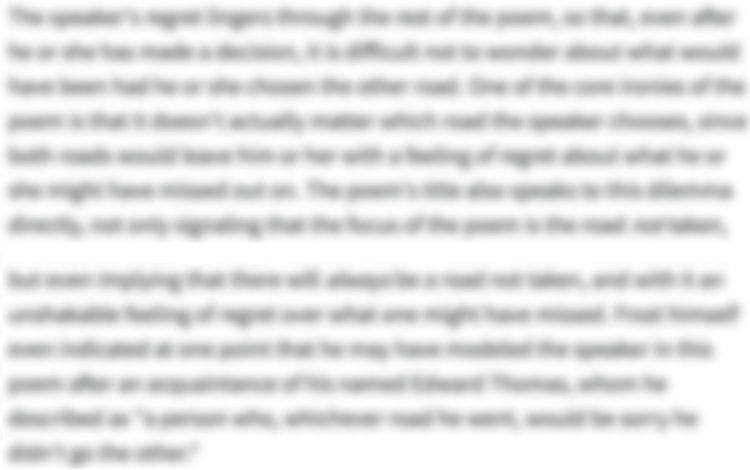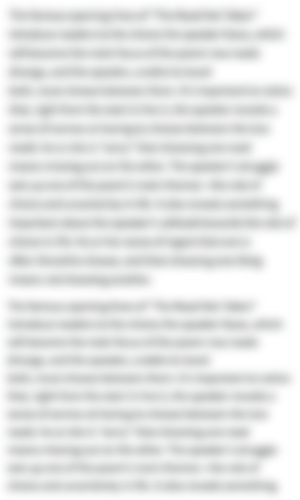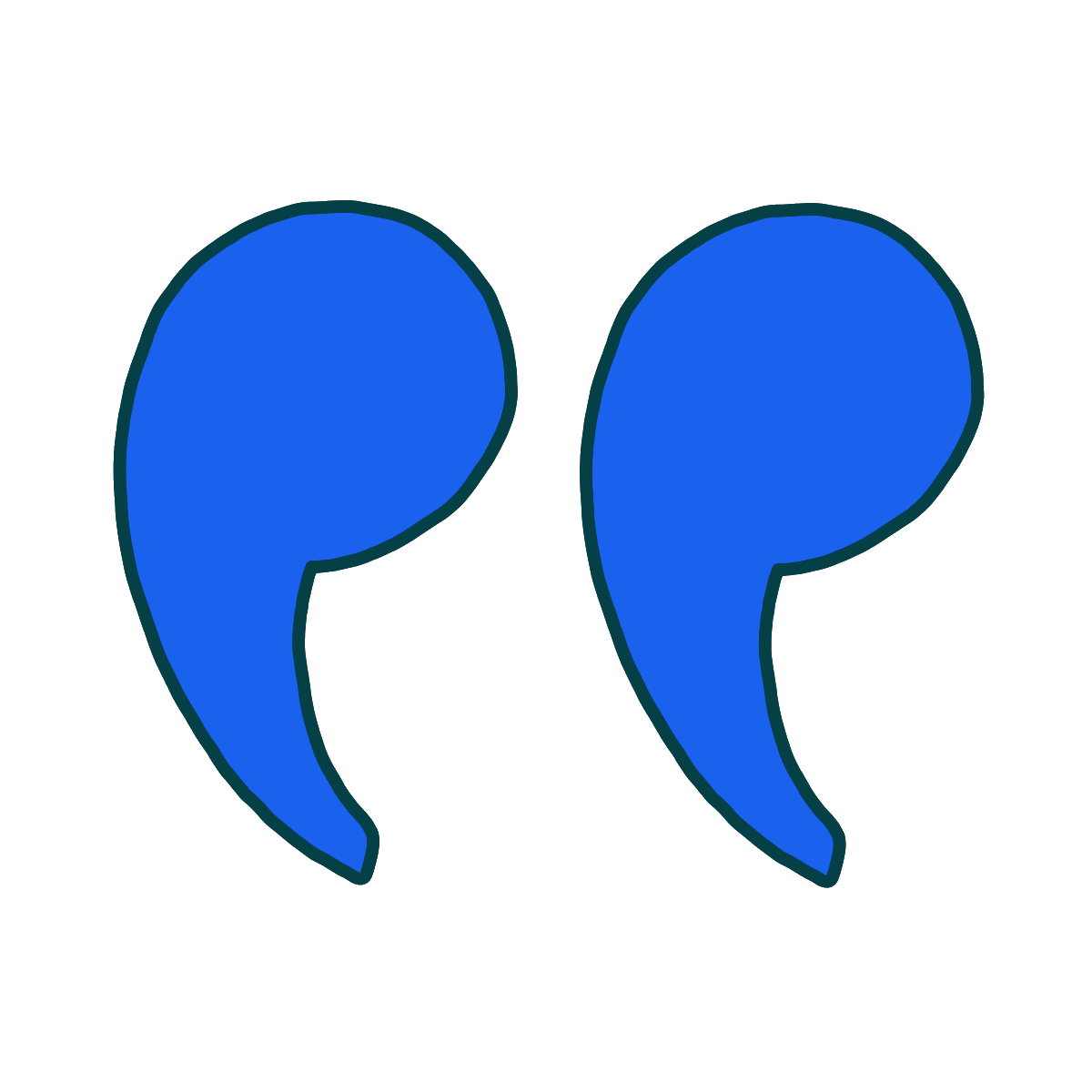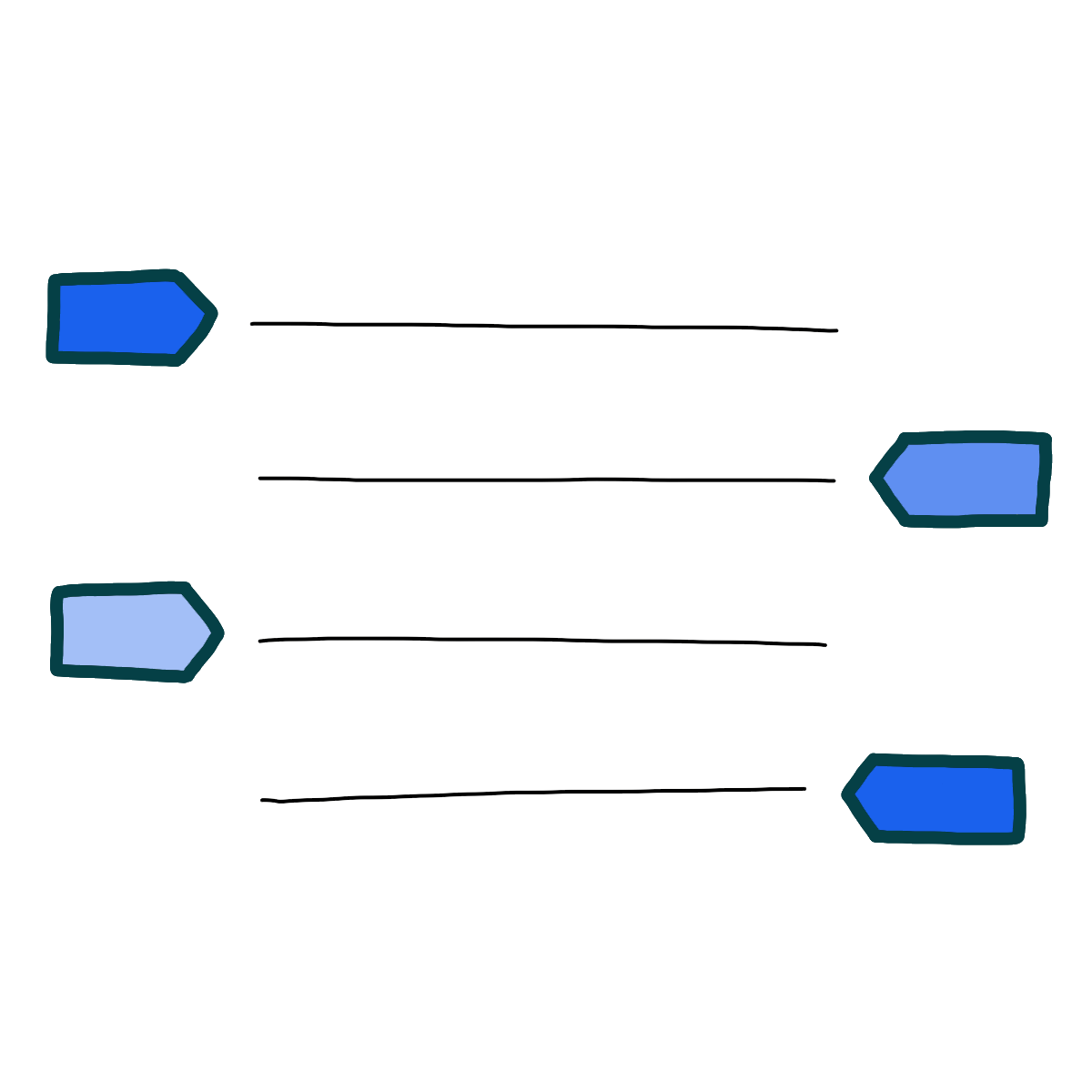-
“Material” Introduction
-
In "Material," Ros Barber meditates on the disappearance of a once-ubiquitous object: the cloth handkerchief. Though the poem's speaker found her mother's frilly "hankies" deeply unfashionable as a child, she has since grown nostalgic for the simpler, more personal world those hankies evoke. The speaker laments that modern life is marked by the mass production of cheap, "disposable" objects like paper tissues, and she also feels guilty about not being as attentive a parent as her own mother was. "Material" was published in Barber's second poetry collection of the same name in 2008.
-
-
“Material” Summary
-
The speaker says that her mother was the queen of handkerchiefs, back when handkerchiefs were still made of fabric—nothing like the packs of paper tissues that people buy these days late at night from corner stores, but back when they were things you would wave from a train's window as it pulled away or use to dab your eyes when crying. Back when handkerchiefs were sturdy, tangible objects, the speaker's mother could always be counted on to have one tucked up her sleeve.
She'd keep hankies stowed in the wrists of all her cardigans, in fact, featuring far too much lace and personalized embroidery. She'd dampen them with spit and then wipe the speaker's face. Sometimes several handkerchiefs would fall out at once, as if she'd been hiding a whole hanky farm in her sleeve where old, withered hankies got together and had little hanky babies.
She'd buy them for herself; the speaker never got her any. Handkerchiefs were the kind of thing aunts you barely knew would send in boxed sets featuring fancy covers with pretentious cursive letters, the least stylish Christmas present imaginable. The speaker's brothers got sent men's versions, in sober colors and which were much bigger, as if boys produced more snot.
Handkerchiefs were responsible for the end of department stores, along with other items of a bygone era like headscarves and shapewear, knitting wool, and devices for smoothing trousers. These mundane objects have no place in today's malls. Hankies were labor intensive: they had to be ironed and boiled clean. As such, the little family-run shops that sold them closed down when the generation of people who used to buy them died.
When hankies disappeared, so did the local produce guy, George, with his unreliable foot, who sold vegetables from a camper van. So did the nice butcher who'd give you a little extra meat, and the seafood vendor with his piles of intensely yellow smoked haddock and neatly wrapped packages of locally-caught crab.
His shop was just across from the dancing school where Mrs. White, with her long, colorful nails, played When You're Smiling from lurching, off-key piano and instructed children to step this way and that. Every year at the local talent show, mothers, fighting off tears, would swiftly pull out a handkerchief from their sleeve to wipe the makeup off their beloved kids' faces.
But longing for the past just makes the speaker feel old. The innocence she wanted her children to hold onto as though it were money got destroyed by television-induced laziness. And the speaker is the one who turned the TV on in the first place, while eating store-bought cookies that she would have made herself if she were a stay-at-home mom.
The speaker doesn't carry handkerchiefs. While her kids were growing up, they looked like they weren't being taken care of and needed strangers to wipe their noses. The speaker wonders why she's always felt so awkward about carrying tissues in her purse, when a travel pack of them costs next to nothing. She misses real handkerchiefs and the gentle, unseen past they evoke.
But that past doesn't belong to the speaker, and she has to accept that it's gone. At some point, she also has to let go of her mother, who left behind only tissues and doubts, not handkerchiefs, when she died. If her mother heard the speaker complaining about rough, throwaway things, she would tell her, "This is what you've got to work with."
-
-
“Material” Themes
-

Tradition, Nostalgia, and Loss
In “Material,” the speaker reflects on the disappearance of the once-common “hanky,” or handkerchief. Growing up, the speaker found the omnipresent hanky “embarrass[ing]”; it belonged to a past her generation rejected. Yet now that the speaker is older, she feels nostalgic for some of the trappings of her mother’s world. Indeed, the personal and durable hanky comes to symbolize a time when people paid closer attention to each other; when everyday interactions were more meaningful; and when products were durable rather than disposable. In longing for the hankies she once despised, the speaker longs for these lost features of the past: traditions and values she realizes had some merit after all.
The hanky is deeply intertwined with the speaker’s childhood memories. For her, it represents a bygone world of slow, thoughtful encounters and well-made objects that people truly valued. The speaker recalls getting hankies as “presents from distant aunts,” and her mother always having several hankies “tucked in" her cardigans. At the “Annual Talent Show,” mothers fighting off “tears / would whip a hanky” out and clean the makeup off “little dears.” The speaker associates hankies, then, with love, family, and kindness—with a world where people looked out for each other.
Hankies were a lot of work, though: you had to “iron[]”and “boil” them in order to clean them. Nowadays, the speaker suggests, people prefer convenience. But in her childhood, people didn’t mind putting time and effort into things that were durable and meaningful. To the speaker, hankies also recall “greengrocer George with his dodgy foot,” who brought vegetables right to one’s door; “the friendly butcher / who’d slip an extra sausage in” for free; the local "fishmonger”; and the dancing teacher with her “out-of-tune piano.” In other words, for the speaker, the hanky recalls a simpler, quainter, more interconnected way of life.
But those past values are gone in today's world, and the speaker feels complicit in eroding them. The speaker says that “Nostalgia” just makes her “old.” In other words, the world is far removed from these things she’s remembering and missing. And she herself was part of the change from old to new: “The innocence” she wishes for her children “was killed in TV’s lassitude” (or lethargy), and she’s the one that “turned it on.” She can’t really be mad about changes she herself was eager to make. Still, she recognizes there was something worthwhile in those old-fashioned “material handkerchiefs.” She seemingly acknowledges that not everything has changed for the better; the modern world, after all, can feel rather cold and “disposable.”
The speaker thus aches for parts of the past she didn’t realize were important to her until they disappeared. In the end, however, she recognizes that she can't simply wallow in "Nostalgia." Instead, she's forced to confront—and embrace—the "uncertainty" left in the wake of those bygone values.
Where this theme appears in the poem:- Lines 2-7
- Lines 17-24
- Lines 50-56
- Lines 60-64
- Line 65
-

Motherhood and Generational Change
The speaker of “Material” recalls how her mother always had a “hanky” at the ready. The speaker associates these handkerchiefs (unlike the “disposable” tissues that replaced them) with her mother’s intense love and devotion—and with the overall style of motherhood exemplified by past generations. She compares her mother’s preparedness for all of life’s ups and downs with her own lackluster parenting skills, claiming that she “raised neglected-looking kids” whose runny noses must be wiped by “strangers.” She feels that her own version of motherhood fails to live up to her mom’s standard. At the same time, she realizes she can’t hold on to an outdated ideal: she must “let it go” and focus on her own “material”—the reality of her life.
The speaker’s fondness for her childhood memories suggests that she wishes she could have devoted as much time and attention to her children as her mother did to her. That her mother was the “hanky queen” suggests that she was always prepared for any situation that might arise. She was ready to wipe up her kids’ tears, “snot,” or makeup after a play. Her hanky was embroidered with her initials, hinting that she took personal pride in her role of cleaning and comforting her children. In contrast, the speaker can’t even be relied on to buy cheap “packs” of disposable tissues Her kids didn’t look cared for to the same extent, and she says strangers had to attend to their sniffles. Whether she means this literally or figuratively, she clearly doesn’t think she is as good a mother as her own mother was.
Still, the speaker’s “material” reality isn’t the same as her mom’s; what she’s mainly feeling, the poem suggests, is that motherhood itself has changed. For one thing, her mother seems to have been a full-time mom, whereas the speaker is rarely “home.” Modern women have much more freedom than women of generations past, but this means they also have more varied responsibilities. The speaker's apparent full-time job left her unable to give her kids the same “innocen[t]” childhood she had. Regardless of her personal responsibilities, she lives in a time when “TV’s lassitude” and “bought biscuits” (store-brand cookies) formed the “material” of her children’s lives. It’s a different world than the one she was raised in.
So while the speaker fondly recalls her mother’s version of motherhood, she finally acknowledges that “it isn’t [hers],” and she’ll have to “let it go.” Nostalgia won't turn back the clock; all she can do is accept the kind of mother she is, and the “material” she has at her disposal. This includes not only the material that goes into tissues and other products but also her life's material—the circumstances she draws on in parenting and writing.
Where this theme appears in the poem:- Line 1
- Line 8
- Lines 9-16
- Lines 46-49
- Lines 57-59
- Lines 66-72
-

Modernity, Mass Production, and Dehumanization
Over the course of "Material," the shift from cloth to disposable handkerchiefs stands in for a larger, dehumanizing cultural trend. Many other beloved things disappear along with cloth hankies, including friendly neighborhood figures such as the greengrocer and butcher, as well as whole categories of (visible) human emotion. Through these details, the speaker suggests that the modern world jeopardizes many people's "material" security, along with the very "material" of human life. That is, it treats certain people, feelings, and interactions as disposable.
The poem shows that not only hankies but various human possibilities—and human beings—struggle to survive in the modern mass economy. Hankies used to signal emotion, such as “grief” or the pain of parting with someone at the “train” station. The speaker suggests that these signals have disappeared along with cloth hankies; the same emotions are expressed very differently now or not expressed at all. Tears wiped away with “disposable [tissues]” feel less precious than tears soaked up with a hanky carried in one’s “sleeve.” The mass production of impersonal tissues reinforces the idea that people’s emotions don’t matter—that they, too, are expendable.
And emotions aren’t the only thing struggling to find traction in today’s fast-paced world. The speaker says the “greengrocer with the dodgy” (or unreliable) “foot” is “history” too. This suggests that disabled people who might have once found work can’t keep up with the demands of an increasingly depersonalized workforce. Likewise, the “friendly” butcher who threw in extra meat for free would no doubt be considered a liability in a world that prioritizes profits over people. No one needs a “fishmonger” now that supermarkets sell everything under one roof, and the dance instructor with an “out of tune piano” would have lost out to competitors.
In a world of mass production, there’s little room for people to be human: flawed, slow, and quirky. What once would have been considered charming is now simply inconvenient or unprofessional. In this relentless modern economy, people must suppress their idiosyncrasies, functioning more as machines than living, interconnected creatures.
The speaker sees these trends reflected in herself and worries about her own repression. She asks herself “What awkwardness” keeps her from carrying “tissues in [her] bag." This suggests that, on some level, she doesn’t even want to acknowledge that she might need tissues. Better not to carry them at all than admit she and others are merely human. That her own kids were “neglected-looking” suggests that her time, energy, and attention were focused elsewhere. Like most people trying to get by in the modern world, she’s hardly ever “home”—she’s too busy working. The poem thus implies that modernity robs people of the connections that make life worth living.
Overall, the poem shows how mass production (and the broader capitalist system) can erode the feelings and interactions that give life meaning. Moreover, it shows how the system eats away at people themselves—making them feel as replaceable as the objects they produce and discard.
Where this theme appears in the poem:- Lines 25-46
- Lines 51-53
-
-
Line-by-Line Explanation & Analysis of “Material”
-
Lines 1-4
My mother was ...
... garages and shops,"Material" begins with the speaker describing her mother as "a hanky queen." To say that someone is the "queen" or "king" of something is an idiomatic expression meaning that they're known for that thing, highly skilled at it, etc. Basically, the speaker's mom used handkerchiefs all the time!
The speaker adds that this was back when handkerchiefs were made of cloth rather than paper. Nowadays, people can buy cheap, disposable tissues at pretty much any hour, at any auto shop or corner store: they're highly accessible and easily replaceable. By contrast, the poem implies that the cloth hankies the speaker's mother used took more time and money to make and acquire, and one wouldn't just throw them away when they were done with them.
These opening lines establish the poem's form. "Material" is a very musical poem, but it never feels overly controlled or stiff. This is thanks in part to its flexible, springy meter, which often falls into iambic tetrameter: lines of four iambs, poetic feet that follow an unstressed-stressed syllable pattern. This meter will become looser as the poem goes on, and, indeed, it already starts to stray from iambs in line 4. Still, the poem begins with a clear iambic bounce that adds to its light-hearted tone:
My mother was a hanky queen
when hanky meant a thing of cloth,
not paper tissues bought in packs
from late-night garages and shops,Every four lines of the poem also fall into an ABCB rhyme scheme. Here, for example, "cloth" creates a slant rhyme with "shops" but "queen" doesn't rhyme at all with "packs." The ABCB rhyme scheme is very common in poetry, and it, like the poem's meter, fills "Material" with recognizable music.
Even as "Material" opens with somewhat traditional meter and rhyme, however, its language is distinctly casual, as if the speaker were talking to a friend. The speaker uses colloquial slang ("hankies," "queen") and the conversational tone makes the poem feel warm and inviting. It also makes the poem feel distinctly modern—which will become important as the poem explores the conflict between the speaker's generation and her mother's.
-
Lines 5-8
but things for ...
... up her sleeve.

Unlock all 241 words of this analysis of Lines 5-8 of “Material,” and get the Line-by-Line Analysis for every poem we cover.
Plus so much more...
Get LitCharts A+ -
Lines 9-12
Tucked in the ...
... against my face. -
Lines 13-16
And sometimes more ...
... raising little squares. -
Lines 17-21
She bought her ...
... gift you'd get— -
Lines 22-24
my brothers too, ...
... had more snot. -
Lines 25-28
It was hankies ...
... today in malls. -
Lines 29-32
Hankies, which demanded ...
... buy them died. -
Lines 33-40
And somehow, with ...
... of local crab -
Lines 41-46
lay opposite the ...
... point! -
Lines 46-49
The Annual Talent ...
... from little dears. -
Lines 50-56
Nostalgia only makes ...
... to being home. -
Lines 57-64
There's never a ...
... and hidden history. -
Lines 65-68
But it isn't ...
... tissues and uncertainty: -
Lines 69-72
and she would ...
... .
-
-
“Material” Symbols
-

The Hanky
Growing up, the speaker found hankies unfashionable and embarrassing, a relic of a bygone era. But as an adult, the speaker comes to view the hankies as a symbol of a slower, gentler way of life. They also represent the speaker's mother's tender care for her children.
Hankies, unlike modern "paper tissues," were made of "cloth." People held onto the same hanky for years, putting in the effort to wash and iron it. These durable hankies represent a time when life itself seemed less "disposable." People cared more for each other in the past, the poem implies, while in the modern day, people care most about convenience.
Hankies also reflected the personality of the person who carried them. Though some hankies were "serious, and grey," others, like the speaker's mother's, were lacy and embroidered in fancy script. This, in turn, speaks to a less homogenous past—a time filled with individuals and rough edges. Unlike the perfect, streamlined supermarkets and malls of the modern day, the era of the hankies was one when quirky characters like the "greengrocer George" could get by selling produce out of his camper van and "Mrs White" could teach dance on an "out of tune piano." Family shops still existed, not yet steamrolled by the mass production of identical products sold in identical stores.
The speaker also links the hanky specifically to motherhood. She notes that her own mom was a "hanky queen," always at the ready to wipe her children's face. Likewise, proud mothers would "smudge the rouge" from their kids after the Annual Talent Show. Hankies were one way that these mothers took care of their children.
The speaker says that hankies recall a "soft and hidden history," suggesting that the past was both somehow gentler and also getting harder and harder to see. The world has moved on; handkerchiefs have disappeared, along with the slower, more interconnected world they represent.
Where this symbol appears in the poem:- Lines 1-2
- Lines 5-6
- Lines 7-8
- Lines 9-16
- Lines 17-24
- Line 25
- Lines 29-32
- Lines 33-49
- Line 57
- Lines 63-64
- Lines 65-67
-

Paper tissues
If hankies represent a way of life that has faded into the past, then the "paper tissues" that replaced them symbolize the convenience, anonymity, and coldness of the modern world.
Unlike the unique, durable, and demanding cloth hanky, paper tissues are "scratchy and disposable." They aren't "presents from distant aunts" and they aren't "Tucked" safely in people's "sleeve[s]." Rather, tissues are "bought in packs / from late-night garages and shops" for "50p." In other words, they're cheap and readily available because people use them once and throw them away. They aren't made to withstand the passage of time, and as such, they have no real value or significance beyond their hygienic use.
These disposable tissues suggest the world has become a place that prioritizes ease of production, price, and convenience over taking pride in one's work, caring for each other, and investing in things that last. To the speaker, the shift from hankies to paper tissues reflected a shift from a warm, slow, meaningful world to one where life itself feels cheap and replaceable.
Where this symbol appears in the poem:- Lines 2-4: “when hanky meant a thing of cloth, / not paper tissues bought in packs / from late-night garages and shops”
- Lines 60-62: “What awkwardness in me forbids / me to keep tissues in my bag / when handy packs are 50p?”
- Lines 66-72: “My mother too, eventually, / who died not leaving handkerchiefs / but tissues and uncertainty: / and she would say, should I complain / of the scratchy and disposable, / that / this is your material / to do with, daughter, what you will / .”
-
-
“Material” Poetic Devices & Figurative Language
-
Simile
In lines 13-16, the speaker uses a simile to joke that her mother carried around so many handkerchiefs it was like she was breeding them. She also personifies her mother's hankies within this simile:
And sometimes more than one fell out
as if she had a farm up there
where dried-up hankies fell in love
and mated, raising little squares.That there could be a whole farm of hankies up her mother's sleeve implies that her mother had a seemingly endless supply of them. This, in turn, suggests how ready for every occasion her mother was, how prepared to help her kids out by wiping away their tears or snot or makeup after a talent show. Unlike the speaker, she was not the type of mother to let her kids run around with runny noses.
Saying these hankies were "dried-up" suggests they were no longer of use, like racehorses that can't race any longer but are still perfectly good for breeding purposes. The image of hanky romance itself is very silly, and it adds to the poem's lighthearted tone. At the same time, the image of hankies getting together and raising little hanky babies reflects the values of the era, when having a family was of utmost importance in society.
Where simile appears in the poem:- Lines 13-16: “And sometimes more than one fell out / as if she had a farm up there / where dried-up hankies fell in love / and mated, raising little squares.”
-
Alliteration
-
Assonance
-
Enjambment
-
Caesura
-
-
“Material” Vocabulary
Select any word below to get its definition in the context of the poem. The words are listed in the order in which they appear in the poem.
- Hanky
- Material
- Cardi
- Spittled
- Ponce
- Naffest
- Trouser presses
- Girdles
- Homely props
- Purified
- Shuttered
- Greengrocer
- Dodgy
- Comma van
- Veg
- Fishmonger
- Haddock
- Parcelled
- Talons
- When You're Smiling
- Ten-bob notes
- Lassitude
- Bought biscuits
- 50p
Hanky-
(Location in poem: Lines 1-2: “My mother was a hanky queen / when hanky meant a thing of cloth”; Line 7: “when hankies were material”; Line 15: “where dried-up hankies fell in love”; Line 18: “Hankies were presents from distant aunts”; Line 25: “It was hankies that closed department stores”; Line 29: “Hankies, which demanded irons”; Line 33: “with the hanky's loss”; Line 48: “would whip a hanky from their sleeve”; Line 57: “There's never a hanky up my sleeve”; Line 63: “I miss material handkerchiefs”; Line 67: “who died not leaving handkerchiefs”)
Slang for "handkerchief," a square cloth used for hygienic purposes (wiping away tears or sweat, cleaning one's nose, etc.).
-
Form, Meter, & Rhyme Scheme of “Material”
-
Form
"Material" is made up of 72 lines divided into nine stanzas. The majority of these stanzas are octaves, meaning they have eight lines each. Stanzas 6 and 7 are irregular, having nine and seven lines respectively, but overall stanza lengths feel pretty consistent. For the most part, stanzas are self-contained, with the exception of stanzas 5 and 6, which are connected by enjambment:
and parcelled rows of local crab
lay opposite the dancing school
The enjambment here mimics what the poem describes: the description of the fishmonger's shop is located just above—"opposite"—that of the dancing school.
The poem also features plenty of colloquial language (including quite a bit of slang). This makes the poem sound modern and conversational, but there's also some tension between the poem's casual language and its fixed stanza length, bouncy meter, and steady rhyme scheme—all of which are features more common in older poetry. The push and pull between more formal and looser verse might subtly reflect the speaker's nostalgia for her mother's era: a time when hankies were made of cloth and the world, in hindsight, felt more familiar and predictable.
-
Meter
Much of "Material" is written in iambic tetrameter: lines of four iambs, or poetic feet that follow a clear unstressed-stressed rhythm (da-DUM). Take lines 1-3:
My mo- | ther was | a hank- | y queen
when hank- | y meant | a thing | of cloth,
not pa- | per tis- | sues bought | in packsThe fourth line breaks with this pattern, before falling back into iambs (for the most part) in lines 5-8:
from late-night garages and shops,
but things for waving out of trains
and mopping the corners of your grief:
when hankies were material
she'd have one, always, up her sleeve.The poem is like this throughout—often iambic, but definitely not always. Most lines do contain four stressed beats, though these aren't always arranged in a steady pattern. As such, readers might call the poem's meter a very loose iambic tetrameter or a four-beat accentual meter that is often iambic.
Whatever the terminology, there's some clear, bouncy music throughout. Steady meters are much more common in older poetry, and the use of meter in this contemporary poem might subtly reflect the speaker's nostalgia for a bygone era. Indeed, the push-and-pull between a regular iambic and freer-sounding accentual verse might echo the tug-of-war going on within the speaker herself, as she lives in the present but longs for the predictability and familiarity of the past.
-
Rhyme Scheme
"Material" follows an ABCBDEFE rhyme scheme throughout. Each stanza can essentially be broken into two quatrains in which the second and fourth lines rhyme with each other while the first and third lines do not.
This is a very common rhyme scheme in poetry, often seen in hymns and nursery rhymes. It adds sweet, lighthearted music to the poem, which fits right in with the speaker's nostalgia for a simpler past. Many of the poem's rhymes are slant: "cloth"/"shops," "aunts"/"ponce," etc. These imperfect rhymes keep the poem feeling a little more down-to-earth than clear, perfect rhymes all the way through otherwise might.
-
-
“Material” Speaker
-
The speaker of "Material" is a woman reflecting on her relationship with her mother and modern life in general. She describes her mother as a "hanky queen" who was always prepared to whip out an elegant handkerchief to clean her daughter's face. Though the speaker was embarrassed when these lacy hankies tumbled from her mother's sleeves, and though she found the hankies she got as Christmas presents from "distant aunts" to be deeply unfashionable, as an adult she longs for the world that the hankies represented: a place where life seemed more thoughtful, communal, and authentic.
Unlike her mother, who "always" had a hanky at the ready, the speaker says that she "raised neglected-looking kids" who had to get their noses wiped by "strangers." She doesn't carry a handkerchief, but also can't quite bring herself to keep a pack of cheap tissues in her purse. Doing so, the poem implies, would be betraying her mother and admitting that the world that the speaker is nostalgic for is really and truly a thing of the past.
Yet the speaker is also acutely aware of the vast generational divide between her and her mother. She feels guilty that she's not a stay-at-home mom (as her own mother likely was) and that she lets her kids watch TV and eat store-bought cookies instead of baking them from scratch.
Nowadays, objects are "scratchy and disposable" rather than "soft," carefully crafted, and meaningful, and the modern world is marked by mass, anonymous production. To the speaker, the loss of things like hankies, local butchers, and so on represents the loss of a simpler, quainter, more connected world.
Though the speaker longs for the bygone era of her childhood, she acknowledges that those memories are now "history" and she must move on. It is her job now to make what she can out of the "material" her life has given her.
-
-
“Material” Setting
-
The poem takes place in the modern world around the time it was written (2008). From this perspective, the speaker looks back on the world of her childhood. The speaker contrasts old-fashioned cloth handkerchiefs with modern disposable tissues to illustrate just how much the world has changed in the intervening years.
In contrast with the throwaway "paper tissues" that people can pick up for next-to-nothing at nearly any corner store today, hankies were sold at department stores or gifted in fancy boxed sets from distant relatives. Unlike cheap, "scratchy" tissues, hankies were "material." People would wave these classy cloths from train windows to say goodbye to loved ones and use them to elegantly "mop[] the corners of your grief" (that is, dab at their tears). In this world, the speaker's mom was a "hanky queen," ready to pull a cloth out at a moment's notice to scrub her children's faces clean.
Like many other household items of their era—"girdles," "trouser presses"—hankies were also fussy and high maintenance. They had to be boiled clean and then ironed into shape. This speaks to the fact that the world the speaker was raised in was slower and less efficient than the one she lives in now; people used to make objects that lasted and meant something, and they would take good care of those objects even when doing so took time and effort. Nowadays, the poem implies, people just buy mass-produced items from the store and throw them away when they're no longer wanted.
The speaker also recalls the local "greengrocer," George, who would deliver vegetables from a van, as well as the kindly butcher who'd sneak you an extra sausage at no charge. Then there was the "fishmonger" who sold piles of fresh seafood across from the "dancing school" where a woman with long, colorful nails taught dance on an "out of tune piano." There was a yearly talent show, where proud mothers used hankies to wipe the makeup off their children after a performance.
All of these details suggest that, in the past, people used to be more connected. The people you bought vegetables and meat and fish from were people you actually knew by name, and if the dance school wasn't exactly perfect, it didn't matter, because there weren't an endless slew of alternatives. In short, the past was a simpler, quainter, more unique place in many ways.
The speaker also nods to the sexism of the era (boys received more "serious" hankies for gifts), but overall she seems to long for the days when life was less polished and more personal. The poem further implies that the speaker feels guilty for not being a stay-at-home mom—for letting her kids watch television and eat store-bought cookies that she'd bake if only she'd "commit to being home." Many of the conveniences of modern life, she suggests, have made that life a little colder.
Indeed, in modern society, everything and everyone feels a whole lot more "disposable." Instead of quirky local shops, there are supermarkets, flashy malls, and a seemingly endless supply of mass-produced stuff. When hankies disappeared, so did the "family stores" that sold them along with people like George. And with their absence, the world feels a little less warm and welcoming.
-
-
Literary and Historical Context of “Material”
Literary Context
Ros Barber is an English poet, novelist, and nonfiction writer. "Material" was published in her second poetry collection, also titled Material, in 2008.
Throughout the collection, Barber pairs traditional tools such as meter and rhyme with personal yet unsentimental subject matter to grapple with timeless themes of loss and longing. Here, Barber balances steady formal elements—octave stanzas, a ballad rhyme scheme, and a bouncy, often iambic meter—with very casual, colloquial language. The result is a poem that feels pulled between the present and the past, reflecting the speaker's own sense of nostalgia for the sweeter, more predictable world of her childhood and her appreciation for her mother's love.
Many other poets have explored similar themes in their work. For example, Simon Armitage's "Mother, any distance" uses the extended metaphor of building a house to illustrate the enduring bond between mothers and children. In Carol Ann Duffy's "Before You Were Mine," a speaker vividly imagines her mother's life in the years before the speaker was born. And in "I Ask My Mother to Sing," Li-Young Lee describes his mother and grandmother nostalgically reminiscing about the China of their youth.
Historical Context
"Material" was written in the early 21st century, at a time when the dehumanizing effects of global capitalism, consumerism, and mass production were becoming painfully clear. Barber herself was born in 1964, at a time when England was still in a post-World War II economic boom. This was a period marked by massive economic growth across the globe and a rapid increase in the mass production of products. With the rise in employment and reliable income, people were buying more than they ever had, which further drove demand for cheap, accessible items.
By the end of the 20th century, the world had changed dramatically. Many small, "family stores" went out of business, replaced by enormous shopping centers (like the "malls" Barber references in this poem). Instead of going to three different people to buy produce, meat, and seafood, people often shopped for all their goods in one place: the supermarket. At the same time, durable yet labor-intensive items like "hankies" were tossed in favor of convenient yet wasteful "paper tissues." The poem suggests that the convenience of modern life has come at a steep cost, as people have become less connected to each other and to their communities.
-
More “Material” Resources
-
External Resources
-
A Reading of the Poem — Watch Barber perform two of her poems, including Material.
-
The Poet's Website — Learn more about Barber's books and other accomplishments on her website.
-
A History of the Hanky — Learn more about the surprisingly fascinating subject of "Material."
-
Saturday Sessions: an Interview with Ros Barber — The poet talks about her novels, her relationship to poetry, and her work as a poetry mentor.
-
-








